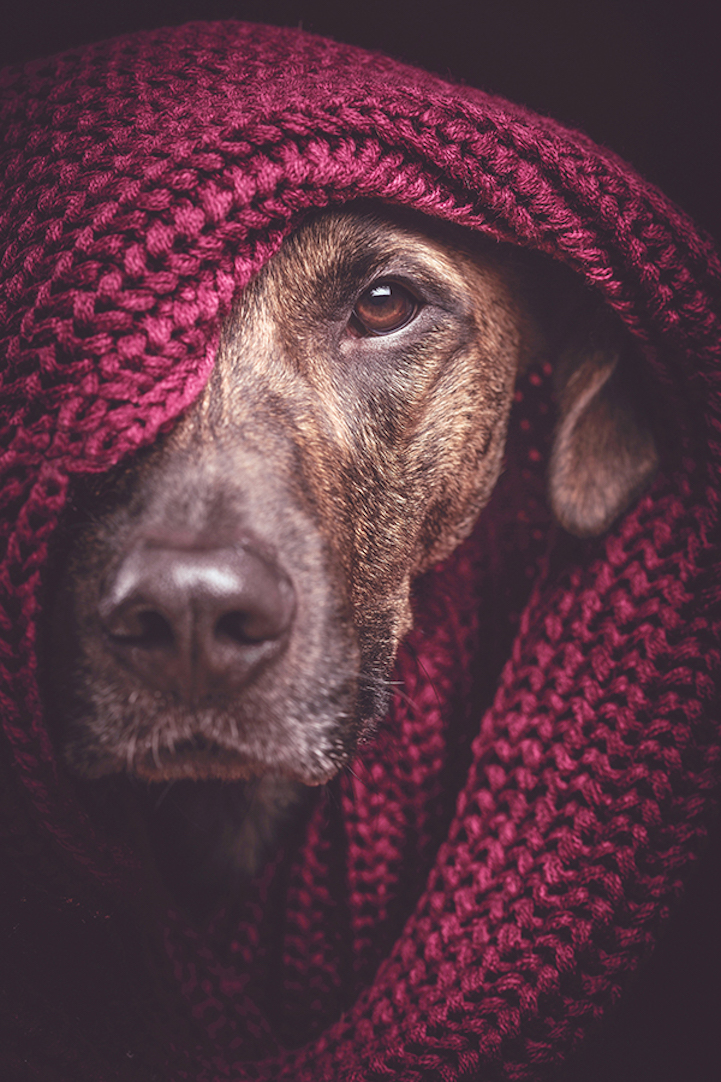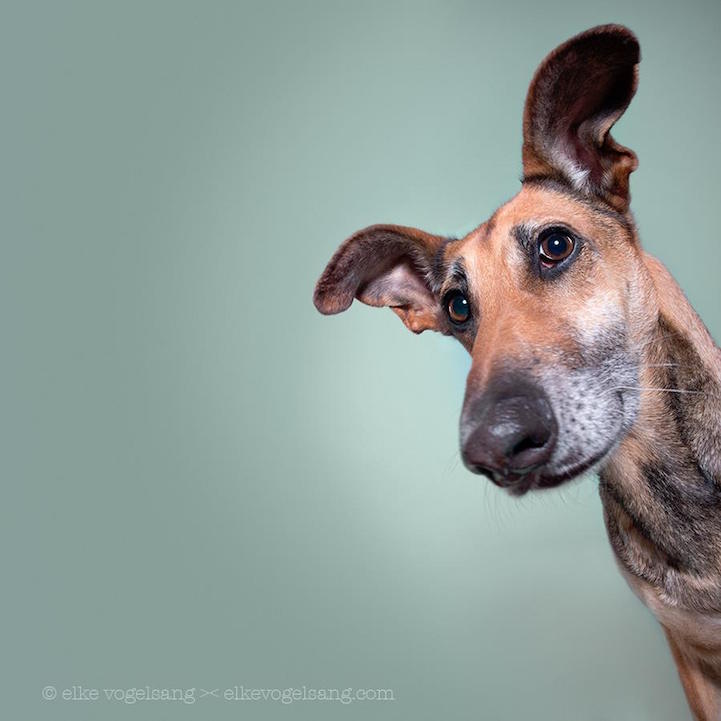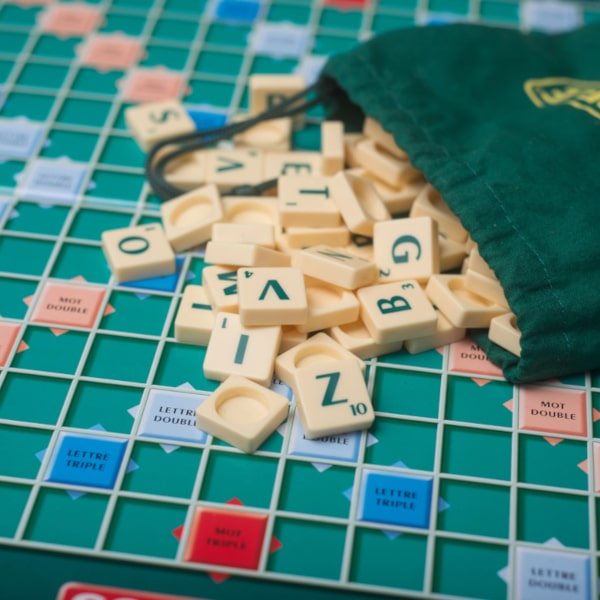
Photographer Elke Vogelsang found a passion for photography after being faced with sudden, significant challenges in her life. During Christmas in 2009, her husband suffered a brain hemorrhage and, for comfort, Elke began taking photos. She kept a visual diary for him during his long months of recovery as a way to deal with his short-term memory loss.
Even after her husband regained health, Elke continued to shoot her favorite subject—their rescued kill-shelter dogs that had saved his life. Eventually, her dedication blossomed into a full-time career. Elke has the patience and ability to bring out the personality of each dog in heartwarming and often humorous portraits, capturing the spirit of these wonderful animals.
We were honored to catch up with Elke for a Behind The Lens look into her pet portraiture! Scroll down to read our exclusive interview.

Can you tell us a bit about your journey into photography?
When I was a child my mother made sure I always had a camera with me on school trips and excursions, but I just snapped and didn’t compose. It was nine years ago, when our first dog Noodles joined us that I had a subject that really grabbed me. Photography turned into a passion when my husband fell seriously ill at Christmas in 2009. He suffered from a brain hemorrhage. The dogs (Noodles and Scout) were the ones who found him in time so he could be saved, but he spent weeks in a coma and months without any short-term memory. Well, that’s a very long story into a very short one…
When my husband was in hospital I took a picture every day as a diary for him when he was not with us and had no memory. I found that photography was a way to distract and comfort me. It was something like a creative outlet. Fortunately, my husband was back home and healthy again after about four months. But this one-picture-a-day project lasted two years. My dogs found themselves in front of the camera very often. I posted the pictures on the Internet, which lead to people asking me if I could photograph their dogs, too. Since I practiced photography daily, my pictures got better and better. The stressful time made me think about life and what to do with it. I wanted to change something. I had a dry and not very creative job as a technical translator. I loved photography a lot and didn’t want to do anything else anymore. This all lead to me combining my two passions—dogs and photography—and becoming a professional photographer. Now, five years later, I’m a full-time photographer specializing in dog portraiture. I do what I love now and couldn’t be happier about it.


What are some of your interests?
My dogs and my photography take up a lot of time. I enjoy listening to music when I edit pictures. Of course, I love to be out with my dogs. I enjoy nature very much.
What keeps you inspired to keep creating?
I’m inspired by books, music, films, tv series, etc. Sometimes I come up with an idea because of some event or something I heard on the news. Since I love to draw as well, I always have the basics of character design in mind. When the BBC announces the new season for Sherlock, I take a picture of my dog in some Sherlock-like way. I do Halloween or Christmas or Valentine’s Day-inspired pictures. But usually the ideas come during the process, and I still take pictures every day. Since my dogs are very keen models and love to pose, we enjoy taking pictures together.

You are able to capture such emotion and personality in every photograph of a beloved pet, how are you able to pose and keep control of each shoot?
Every individual dog is so very different. They say, “Never work with children or animals,” but I enjoy exactly that. It’s so rewarding to finally be able to present an interesting portrait of a dog, though the owner thought that the dog would never cooperate. Some dogs react to noises quite well. There are dogs who do the cutest head tilts whenever you say one of their favorite words. Yes, dogs have favorite words and they understand quite a lot. This could be the name of the favorite treat or the name of the child of the family. My Noodles reacts to quite a lot of words. Her favorite words are my husband’s name and the German word for “treat.” Lots of dogs react to noises. I always try low volume sounds. This could be a clicking of the tongue, humming or whistling. Nevertheless, dogs usually get used to you doing strange noises very quickly. Then I go for treats. This usually works well in most cases. Toys could also be an option for some dogs, but some dogs get overly excited when presented with their favorite toy.
But, there are also dogs who are not motivated by anything. These are the real challenge. Some older dogs are just too cool to fall for cheap tricks like this. Always be calm and make sure the dog feels comfortable. Most of all, make sure the session is fun not only for you but also for the dog. The art lies in finding the interesting pictures among the shots you did.


You traveled to Morocco to photograph stray dogs, can you tell us about that experience?
My three dogs Noodles, Scout, and Loli are rescue dogs from Spain. They were saved from kill shelters and brought to Germany to find a home. (As it turned out, they were life-savers themselves later on.) Our dogs mean a lot to us—they are family members. I would love to give something back. I know how giving and loving rescue animals can be. Therefore, I promote adopting dogs from shelters. My journey to Morocco was aimed to raise awareness for the situation of dogs in this country. There are stray animals everywhere in Morocco. I thought I was prepared for the situation, but I wasn't. I can only imagine what it must be like for the people trying to improve the situation. It's like a bottomless pit and a fight against windmills. Nevertheless, I’m not going to another country in order to point my finger at another people. I just want to raise awareness and support the people trying to save some of the animals.
How much planning goes into a shoot?
Actually, I don’t plan much. Since dogs are mostly unpredictable, I have to find out for every individual dog how to motivate him or how to approach this special character. I’ve got my tricks and techniques, but every dog is so very different and with every dog you learn something new. Of course, I know a bit about the preferences and behavior of my own dogs. With them I’m able to also do planned sessions. But still, I prefer letting the ideas come from the process.


How do you light your photos? Do you use artificial or natural light?
When shooting outdoors I use available light. Very seldom I use a flash outdoors. In the studio I have three flashes with a maximum power of 400 Watts. You don’t need too much power to light dogs. Most dogs don’t care about the flash, but some dogs might find the lights and noises irritating, therefore, I keep the power low. For noise-sensitive dogs I use continuous light in the studio.
How would you define your style?
I try to concentrate on character and personality. My pictures show emotions and might be whimsical, quirky, funny and sometimes melancholic or sad. I love to keep it simple and don’t use many props. I concentrate on the dog and its personality.
What message do you want your photographs to convey?
Dogs are funny characters. They find pleasure in the most mundane things. My dogs are my joy, inspiration and constant source of laughter, though they can be shy and sad as well. They have also comforted me in bad times—dogs have all the emotions that human beings have.
I try to explore the emotional, funny, quirky side of dogs and dog photography. I would definitely say that they enrich my life, and I hope I can at least give them back half of what they give us. It’s an homage to dogs, life and photography.

Animals are often unpredictable, what challenges have you faced while creating with pets?
With energetic dogs, outdoor pictures are easier achieved. I make the owner entertain the dog and take pictures while the dog is in action and having fun. A real challenge might be old dogs. Old dogs can be very cool and relaxed and not easily motivated. Of course, there could also be health problems which you should be aware of and make sure you don’t overexert the dog. I make sure the sessions are short and not too hectic. I always try to figure out what a dog is able to do. Puppies are easier photographed than you might think. They still find everything interesting.
For portraits or studio pictures you need more strategies to make sure the dog poses for you. Often enough the real challenge is the owner, who is more nervous than the dog himself. That’s why I try to make sure the owner just sits somewhere near the dog if the dog needs to be reassured of the presence of the owner. But the owner should try to stay calm and just hold a treat if necessary, but otherwise they should not interfere. For portrait pictures, I make sure the atmosphere is calm and relaxing. You can tell when a dog is nervous.
Every dog might be a challenge on its own. I love when a dog is stubborn and has its own will. I adore such characters. I once had a dog in my studio that just couldn’t be bothered at all. She seemed to think that I was slightly ridiculous and the whole session a waste of time. I took pictures of her looking exactly like that. She finally decided to lie down and sleep. Usually, I would, of course, try to motivate the dog and make sure it finds the session interesting. But in this case the owner, as well as I, were so charmed by her character that those pictures were exactly what we hoped for. The best compliment I can get is when the owner says that my pictures show the character of the dog.


What is a must-have in your gear bag?
I’m not a gear geek, I love to keep it simple. I swapped my DSLR for mirrorless cameras, which are not that heavy and bulky. My favorite camera is now the Fujifilm X-Pro2. For more elegant portraits I use a lens with a focal length of 90mm, and for quirky pictures I use a wide-angle of 18mm in order to get some distortion. My most successful photos were shot with very basic cameras for beginners. I believe that you are the most creative the more restricted you are with your equipment.
How much post processing goes into a completed photo?
Not much. I hardly ever manipulate the expressions of the dogs, because I would like to make sure the dog is still recognizable and the picture is still a realistic representation of the animal. I use Photoshop to clone out loose fur or some slobber. Furthermore, I do the usual adjustments for contrast and colors, etc.

What are your plans for the future? Do you have any upcoming projects?
I’m currently working on a second picture book with dog pictures. I also want to travel more. There will be workshops in the United Kingdom and elsewhere.
Do you have any advice for aspiring animal photographers?
You should definitely be familiar with the species you would like to shoot—know their behavior and body language. Furthermore, I think that you should love what you photograph. If you don’t like dogs, don’t become a dog photographer. The pictures will show this.
When working with animals, be calm and relaxed. Never hassle an animal to get a shot. Ask the owner beforehand about the character of the animal. Does it have any character traits that make it special? Does it know some tricks? What might motivate the animal? I usually shoot for a maximum of two hours. The dog has to concentrate hard for a photo session. Take frequent breaks.

Thank you so much, Elke! If you would like to see more of inspiring photographer's work, check out her website!
Are you a photographer? Would you like to be interviewed for the Behind The Lens series? Leave your links in the comments below!






















































































